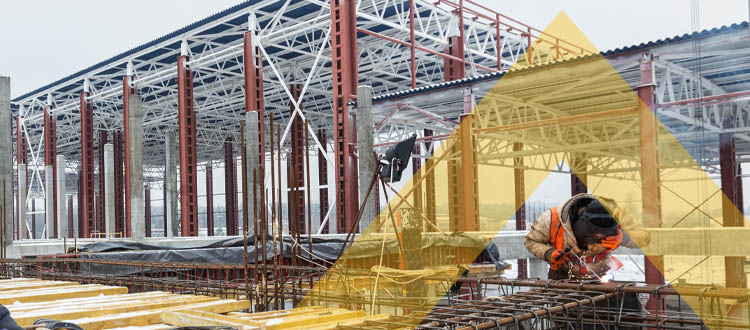
If you want to predict the construction industry’s economic trajectory, my professional philosophy has always been “Keep an eye on the AIA Billing Index.” Why? Because it’s pretty consistent: when architects are slow upstream, contractors tend to be slow downstream.
We’re in October now, and for eight out of the past 10 months, the Billing Index has been trending below 50. This isn’t a great sign for the industry, so as we finish up the year, there are two primary factors I’ll be observing closely:
- The current state of the AIA Billing Index and what it means for the upcoming months.
- The projects and sectors that are flourishing despite the AIA Billing Index’s indications.

Understanding the AIA Billing Index
The AIA Billing Index — or the Architectural Billings Index — is a monthly survey conducted by the American Institute of Architects.
The results of the survey indicate the current status of the architecture — and, by extent, construction — industry. By and large, throughout construction, the Billing Index is considered to be a reliable indicator of impending economic health because it measures architects’ work, which usually precedes actual construction.[1]
Think about it like this: architects are the ‘planners’ and construction professionals are the ‘doers.’ If architects aren’t busy drawing up project plans, contractors won’t have construction projects to work on.
The Billing Index is measured on a scale of 0 to 100 — 50 is the neutral point. A score above 50 indicates an increase in billings, reflecting growth in demand for architectural services. A score below 50 indicates a decline in billings, and, by extension, reduced demand. [2]
It’s important to note that the Billing Index is broken down into four regions and four sectors. Regions include the Midwest, South, West and Northeast. Sectors include institutional, commercial/industrial, residential and mixed practice.
The Current State of the AIA Billing Index
As mentioned, the AIA Billing Index has been trending below 50 for eight out of the last ten months. Now, a Billing Index value below 50 doesn’t necessarily mean doom and gloom for the industry as a whole, it just indicates that the industry is moving slower than the previous month.[3]
Still, it’s important to be cautious and to remember that when a trend like this continues over an extended period — as we’re starting to see — it can indicate broader economic issues, like uncertainty in funding or reduced investor confidence.
In September, architecture firm billings declined sharply.[4]
The Billing Index score for September was 44.8. It is the lowest score reported since December 2020, during the height of the pandemic. This indicates that the share of firms reporting a decline in billings has significantly increased.
The value of newly signed design contracts also slumped in September. This indicates increased reluctance among clients to sign contracts committing to new projects.[5]
As I previously mentioned, though the AIA Billing Index does indicate some areas of concern, that doesn’t mean that things are all bad across the board. Some sectors are doing very well, despite the Billing Index’s observations.
What’s Working in Quarter Four?
As of October, two commercial construction specialties are flourishing:
- Megaprojects and government work
- Heavy highway projects
I recently had the privilege of being on a webinar with Associated Builders and Contractors Economist Anirban Basu.
Basu spoke further on how we’re in an era of what some are calling “mega projects.” He was referring to the plethora of big public and private jobs being completed around the country.
These large-scale endeavors contribute significantly to the industry. They often require significant architectural and construction services, which can help offset the slowing commercial market.
Megaprojects provide job opportunities, thereby stimulating local economies. Because of their long-term scope, these projects also give participating contractors increased job stability.
Similar to these megaprojects, the strong performance of heavy highway work and heavy civil projects are serving as a counterbalance to the Billing Index’s downward trend. The government’s investment in these infrastructure projects can provide a cushion against the downturn in other sectors, creating further opportunities for growth and security in the construction industry.
These two elements — heavy highway work and megaprojects — will hopefully bolster the construction sector as we enter quarter one of 2024.
These large-scale endeavors don’t only offer job opportunities, they also have the potential to stimulate the economy. Some government-funded jobs — like those stemming from the $7.5 billion in new funding for EV charging stations from the Infrastructure Investment and Jobs Act — even encourage technological advancements.[6]
How Should Contractors Plan for 2024?
As we approach the end of the year and prepare for 2024, construction companies must keep a close eye on the AIA Billing Index. While it may not be an infallible predictor of the industry’s future, it offers valuable insights into the current state of the economy and the future.
Still, knowing that the AIA Billing Index has been trending below 50 for much of this year, contractors should be cautious about expecting rapid growth. While there is reason for optimism, it is always prudent to be prepared for anything.
To best plan for the future, construction companies should consider the following actions:
- Diversification: When contractors diversify their capabilities into areas with strong demand, it can help to assuage the impact of a declining AIA Billing Index.
- Cost Management: With uncertainties in the industry, it’s wise for contractors to keep a close watch on their expenditures. Efficient operations are crucial for maintaining profitability.
- Continuing Education: Being flexible and ready to pivot when opportunities arise is a valuable trait in the construction industry. The landscape can change rapidly, and businesses should be agile enough to respond. Continuing education and additional training can provide great opportunities for contractors to prepare for additional opportunities that may come their way.
- Monitoring Trends: Monitoring the industry through tools like the AIA Billing Index — and keeping tabs on government funding and mega project opportunities — will help businesses stay ahead of the curve.
In Parting
The construction industry’s performance is closely tied to economic health, and the AIA Billing Index is a valuable gauge of its trajectory. Its trend below 50 for a substantial part of this year raises concerns, but there are reasons for cautious optimism thanks to the investments in megaprojects and highway work.

Construction companies must navigate this terrain with vigilance and a keen eye on market trends. While challenges persist, the industry remains resilient, and the right strategic choices can lead to economic advancement and stability even in the face of a negative AIA Billing Index trend.
[1] https://inside.lighting/lighting-industry-market-info/architecture-billings-index/
[2] https://www.aia.org/resources/10046-the-architecture-billings-index/
[3] https://insights.cumming-group.com/aia-architectural-billings-index/
[4] https://www.aia.org/pages/6680261-abi-september-2023-architecture-firm-billi/
[5] Ibid.
Share Article
Keep on current news in the construction industry. Subscribe to free eNews!
Our Top 3 YouTube Videos
Learn about our software more in depth with product overviews, demos, and much more!

Our ACA reporting & e-filing services include official 1094-C and 1095-C IRS reporting, optional e-filing (no applying for a TCC code required), mailing to your employees and experienced support to help you.

There are plenty of reasons to make FOUNDATION your choice for job cost accounting and construction management software — just ask our clients!

From job cost accounting software, to construction-specific payroll. Get an overview on your next all-in-one back-office solution.



